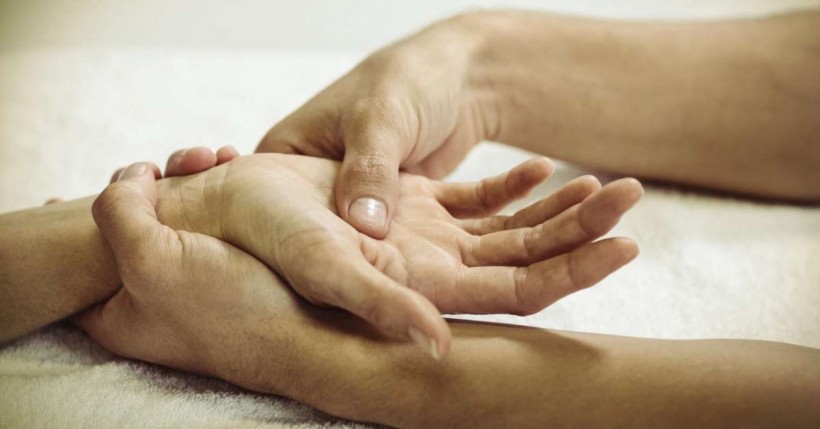
One of the most widely known traditional philosophies is the ancient Japanese Art of Jin Shin Jyutsu. Jin Shin Jyutsu is an art of living and is based on our ability to harmonize and balance the life energy in our bodies at a mental, physical, and spiritual level. Although Jin Shin Jyutsu predates Moses and the Buddha, it was rediscovered in the 20th century by Master Jiro Murai, and since then, it’s been passed down from generation to generation.
According to this physio-philosophy, our bodies have different pathways through which energy flows. Blocking one or more of these energy pathways results in discomfort or pain. And tension is singled out as the primary cause of different body symptoms.
This tension can be relieved by stimulating certain spots on our fingers since each finger is connected to a different emotion, organ, symptom, and illness. So, by gently massaging the appropriate finger while breathing slowly and deeply, you can relieve tension and alleviate symptoms of both physical and psychological conditions in your body.
The effectiveness of Jin Shin Jyutsu has been backed by science. For example, one study examined the effect of training 20 nurses in the self-care methods of this ancient philosophy for one month.
The results indicated a considerable increase in gratitude, calmness, positive outlook, and motivation in participants. Whereas negative emotions, such as resentfulness and anger and stress, and depression, were considerably reduced. In addition, participants said that they had fewer headaches and muscle aches (1).
In what follows, we’ve presented what organs and conditions each finger is connected to:
Organs: Spleen and stomach
Physical Symptoms: Headaches and digestion problems
Mental States: Anxiety, depression, obsession, and hate
Helps With: Back of head discomfort, digestive and breathing problems, and physical fatigue
Organs: Kidneys and bladder
Physical Symptoms: Toothache and back pain
Mental States: Mental confusion, frustration, perfectionism, timidity, criticism, and depression
Helps With: Discomfort felt in the upper arm, elbow, and wrist and digestive problems
Organs: Liver and Gallbladder
Physical Symptoms: Dry cough, eye strain (ocular fatigue), and mental fatigue
Mental States: Emotional, indecisive, irritable, angry, and unstable
Helps With: Discomfort in the forehead as well as eye and general fatigue
Organs: Large intestine and lungs
Physical Symptoms: Breathing problems
Mental States: Negativity and grief
Helps With: Ear discomfort and breathing issues
Organs: Small intestine and heart
Physical Symptoms: Sore throat, nervousness
Mental States: Nervousness, insecurity, and confusion
Helps With: Bloating and calming of nerves
In addition, the tips of your fingers are also connected to different organs. Gently massaging the fingertips can help alleviate symptoms of several conditions, such as breathing issues, sore throat, fever, headaches, and earaches.
Here is what organ each fingertip is connected to:
The thumb – Diaphragm
The index finger and middle finger – Head
The ring finger – Ears
The pinkie – Solar plexus
The joints in your fingers are connected to your ears and eyes. Applying gentle pressure to the joints in your fingers can help with eye strain, eye pain, and tinnitus (ringing in the ears). Additionally, proponents of acupressure claim that massaging the joints in your fingers can aid with digestive problems, particularly for children.
This pressure point is located at the edge of your palm. It starts from the tip of your thumb and ends right beneath the area where your wrist creates a crease. Applying gentle pressure to this area of your hand can help ease symptoms of the common cold, such as sneezing, sore throat, chills, and runny nose.
To find out where the inner gate point is, you’ll need to place three fingers above the crease of the wrist of your other hand. Proponents of acupressure recommend that you apply firm pressure to this point to relieve stomach pain or nausea and improve your digestive system.
If you place three fingers above the crease of your wrist on the top side of your other arm, you can find the outer gate point. It is located between two tendons. Proponents of acupressure claim that massaging this point can boost your immune system and increase your energy.
This pressure point is located in the crease of your wrist. Gently pressing the heart 7 pressure point can help alleviate symptoms of anxiety, and depression as well as protect against heart palpitations and insomnia.
One study which examined how hand reflexology affected anxiety in patients with coronary angiography found that anxiety levels were considerably decreased after the intervention (2).
The Hand Valley Point
You can find the hand valley point between your thumb and index finger. Reflexologists believe that applying pressure to this point can help relieve toothaches, neck pain, shoulder pain, migraines, and lower stress levels.
The Small Intestine 3 (SI 3)
This pressure point can be found right below your pinkie finger at the outside part of your hand.
Reflexologists claim that applying firm pressure to this point can help alleviate neck pain, headaches, and earaches.
This pressure point is located right at the base of your thumb, on the wrist crease. Reflexologists say that applying gentle pressure to this point may help with breathing and respiratory issues. It’s also believed that massaging this pressure point can help regulate your emotions.